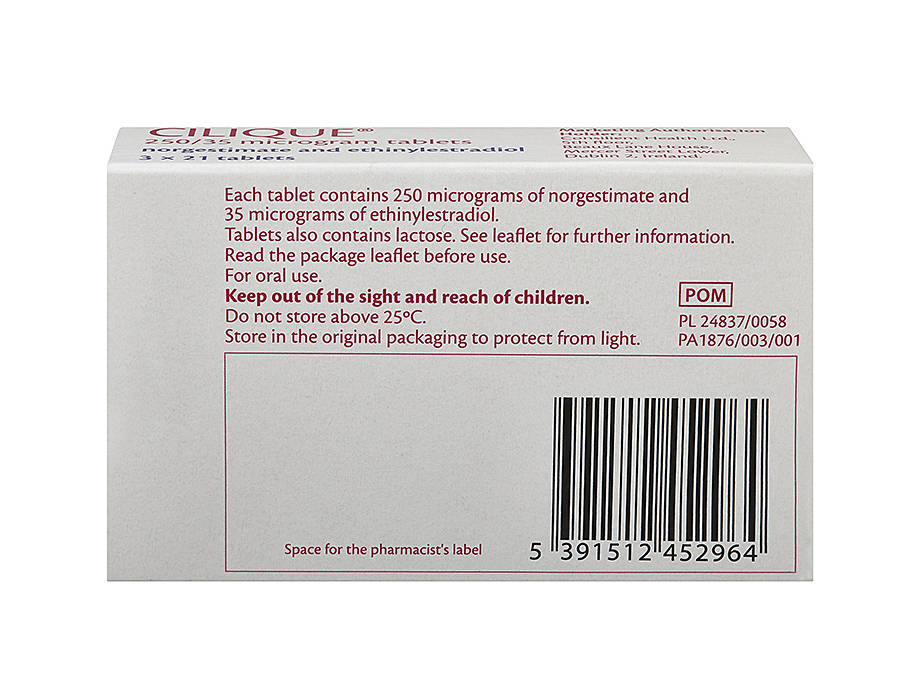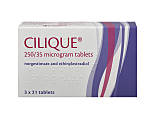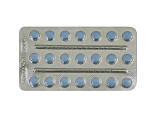Cilique
Cilique is a reversible contraceptive pill you can take to prevent pregnancy. Choose Cilique to regulate your periods and make them lighter. It is suitable for women up to the age of 50.








Prices from £18.00
Out of stock. Simply fill in a brief questionnaire. One of our doctors will review your order and prescribe a suitable treatment. How to Order
-
Cilique is a hormonal contraception pill used for birth control and is made by CYNDEA PHARMA.
Each Cilique pill contains 250 mcg of norgestimate (a progestogen) and 35 mcg of ethinylestradiol (an oestrogen).
Cilique is a reliable combined contraceptive pill that you take daily for 21 days and then have a 7 day break. With Cilique, your periods will be lighter and less painful. Cilique can also help with premenstrual symptoms (PMS).
If you take Cilique for a long time, it can reduce your risk of ovary or womb cancer.
You can order Cilique online from Asda Online Doctor. Fill in an online questionnaire and one of our doctors will review your answers. Get your Cilique through our discreet delivery service, or you can collect at a nearby Asda Pharmacy.
Prices
3 x 21 tablet(s) / 250/35 mcg - £18.00
6 x 21 tablet(s) / 250/35 mcg - £27.00




About Cilique
How does Cilique work?
Cilique contains two types of female sex hormones which are similar to what your body naturally produces. These are norgestimate, a progestogen, and ethinylestradiol, an oestrogen. These hormones in Cilique work to:
- stop you from releasing an egg from your ovaries during ovulation
- make the fluid (mucus) in your cervix thicker which makes it harder for sperm to enter your womb
Cilique does not prevent you from getting sexually transmitted infections (STIs) like HIV. Use a condom to protect yourself and get regular STI checks at a sexual health clinic.
Who can use Cilique?
You can take Cilique if you:
- have never had a blood clot or blood clotting disorder
- do not have hepatitis C
- do not need an operation soon
- have never had a heart attack or stroke
- do not have angina
- do not have severe diabetes
- do not have very high blood pressure
- have low levels of fat and cholesterol in your blood
- do not have hyperhomocysteinaemia
- do not have womb, liver or breast cancer
- do not have migraines with aura
- have a healthy liver
- are not allergic to any of the ingredients in Cilique
- do not have unexplained vaginal bleeding
- are not pregnant or breastfeeding
Please read the patient information leaflet and speak to your doctor for advice before you take Cilique.
-
-
Cilique is easy to take as the foil blister strips are marked with the days of the week. There are arrows to help you remember which pill to take next. To take Cilique you should:
- Take one Cilique pill at the same time each day for 21 days. Follow the days and arrows on the blister strip to help you.
- Each pill should be swallowed whole, with water if this helps. Do not chew the pill.
- After 21 days, you will finish the strip. Then you will have 7 days where you do not take any pills.
- During your 7 day pill break, you should have a withdrawal bleed. This will be similar to your period. You don’t need to use additional contraception, such as condoms, if you have taken your pills correctly and start your next pill on time
- Start your next strip of 21 Cilique pills even if you are still bleeding.
You can also take Cilique in other ways. For more information please speak to your doctor.
Your Cilique pill might not protect you from pregnancy if you vomit or have severe diarrhoea. If this happens, speak to a doctor or pharmacist for advice.
-
-
Start taking Cilique on the first day of your period (the first day of your menstrual cycle). This will protect you from pregnancy from your first pill onwards. You can also take your first Cilique pill on days 2 to 5 of your menstrual cycle.
If you start taking Cilique on day 6 or later of your menstrual cycle, you need to take it for 7 days before you are protected from pregnancy. Use a condom during these 7 days.
-
-
If you forget to take Cilique, it may make your pill less effective. A pill is considered as being missed if it is taken 24 or more hours after the usual time.
- If you have only missed one pill, take it as soon as you remember, even if you have to take 2 pills at once. Continue to take the rest of your pack as usual. You’ll still be protected against pregnancy.
- If you have missed 2 to 7 pills, take the most recently missed pill as soon as you remember and leave any previous pills in the strip. This may mean taking 2 pills at once. Continue to take the rest of your pack as usual. But if you have fewer than 7 pills left in the pack, start a new pack without taking a pill free break. You will need to use extra contraception such as condoms for seven days as you may be at risk of pregnancy.
- If you miss 2 or more pills in the first week of your packet, or if you miss 8 or more pills you may need emergency contraception from a healthcare professional.
Speak to your doctor or pharmacist for advice if you are unsure about what to do after missing a Cilique pill.
-
-
If you take Cilique twice you may feel sick, vomit, or have some vaginal bleeding. Contact your doctor for further advice.
-
-
If you are pregnant or breastfeeding you should not use Cilique. Speak to your doctor or family planning nurse for advice about taking Cilique. They can discuss alternative contraception with you such as taking a progesterone only pill.
-
-
You should use a different form of contraception if you stop taking Cilique as you will not be protected from pregnancy. You may also experience some vaginal bleeding a few days after your last Cilique pill. Speak to your doctor or pharmacist about other forms of contraception if you still want to prevent pregnancy.
-
-
You may experience some side effects when you take Cilique. Some common side effects of Cilique include:
- Headache or migraine
- Stomach problems
- Bleeding between periods
- Mood changes
- Trouble sleeping
- Skin rash
- Muscle spasms
- Weight gain
- Breast pain
- Vaginal discharge such as thrush
Uncommon side effects of Cilique include:
- Skin feeling itchy, red or changing colour
- Changes in hair growth
- Changes in sex drive
- Dry eyes
Rare side effects of Cilique include:
- Loss of sex drive
- Faster heart beat
- Pancreatitis
- Sweating
- Sensitivity to light
- Blood clots
- Cancer
If you take Cilique, your risk of thrombosis (blood clots) slightly increases. You can get a blood clot in your:
- Leg (deep vein thrombosis or DVT)
- Lungs (pulmonary embolism)
- Eye (retinal vein thrombosis)
- Heart (heart attack)
- Brain (stroke)
If you’re experiencing any of these side effects, please speak to your doctor as soon as possible. You can find out more about the possible side effects of Cilique in the patient information leaflet that comes in your pack of pills.
You might have breakthrough bleeding or spotting within the first few months of taking Cilique. If it doesn’t stop after 3 months, please get in touch with your doctor.
You can report any side effects using the MHRA Yellow Card Scheme in the Google Play or Apple App Store.
-
-
Cilique can interact with some medicines or foods. This means Cilique might not work properly if you take them together. You should speak to your doctor to check if you can take Cilique with any of the following:
- medicines used to treat epilepsy such as topiramate, carbamazepine, phenytoin, oxcarbazepine, primidone, lamotrigine or rufinamide
- medicine for high blood pressure such as bosentan
- medicines for tuberculosis such as rifampicin and rifabutin
- HIV medicines, including antivirals
- medicine to treat hepatitis C such as boceprevir and telaprevir
- medicine to treat nausea or vomiting such as aprepitant and fosaprepitant
- medicine for fungal infections such as griseofulvin, itraconazole, ketoconazole, and fluconazole
- modafinil to treat sleepiness
- sedatives such as barbiturates
- supplements or vitamins that contain the herbal remedy St. John’s wort
- metoclopramide for gut mobility
- charcoal
- medicines for high cholesterol levels such as colesevelam, atorvastatin, or rosuvastatin
- medicines for pain and fever such as paracetamol or aspirin
- medicines for arthritis pain such as etoricoxib
- vitamin C (ascorbic acid)
- grapefruit juice
- medicine to treat stomach acid problems such as omeprazole
- medicine after transplant surgery such as ciclosporin
- medicines for inflammation such as prednisolone
- medicines for your lungs such as theophylline
- medicines to treat diabetes such as insulin
-
-
The active ingredients in Cilique are norgestimate (250 micrograms) and ethinylestradiol (35 micrograms).
The other ingredients in Cilique are maize starch, lactose, magnesium stearate (E470b) and indigo carmine (E132).
If you have lactose intolerance or allergies to any of the ingredients listed here, please speak to your doctor for advice before taking Cilique.
-
-
Cilique works in the same way as Cilest and is equally effective. Cilique and Cilest pills both contain the same active ingredients (250mcg of norgestimate and 35mcg of ethinylestradiol). Cilique is made by a different manufacturer and contains different inactive ingredients. However, Cilest was discontinued in 2019 and is no longer made.
-
-
-
-
You should store Cilique away from the sight and reach of children. Do not store Cilique above 25ºC and keep it in its original pill packet. Do not use Cilique after the expiry date printed on the strip. The expiry date refers to the last day of that month.
-
-
You should not throw away Cilique in the bin or down the drain. Take your Cilique pills to a nearby pharmacy so they can dispose of it safely.
-
-
Cilique looks like a round, blue, biconvex pill.
-
-
Cilique is available in a pack size of 3 or 6 blister strips. Each Cilqiue blister strip contains 21 pills.
-
-
The Marketing Authorisation Holder of Cilique is Consilient Health Ltd., 5th floor, Beaux Lane House, Mercer Street Lower, Dublin 2, Ireland.
The Manufacturer of Cilique is CYNDEA PHARMA, S.L. Polígono Industrial Emiliano Revilla Sanz. Avenida de Ágreda, 31, Olvega, 42110 Soria.

Crystal qualified in Medicine at Barts and the London School of Medicine and Dentistry in 2010. She then trained as a GP in London hospitals and practices. She has a particular interest in reproductive, sexual, and women’s health.
Meet our doctorsLast reviewed: 01 Sept 2021
-
https://www.hpra.ie/img/uploaded/swedocuments/c052632b-b378-4eb4-a14f-7b5204fadffd.pdf [Nov 2019] [accessed August 2021]


GMC: 7074021

GMC: 6149061

GMC: 7085115







